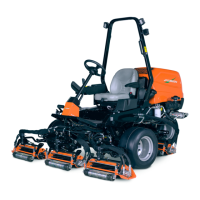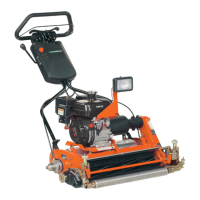HYDRAULICS
8M-65
8. Slowly continue to close load valve until zero flow
is obtained. Read and record implement relief
valve pressure D) on Flow Test Report 1. Pres-
sure should be 1000 psi ±10% (69 Bar).
Conclusion
• If leakage is less than 1 gpm (3.8 lpm), pump is not
at fault.
• If leakage is 1 to 1.5 gpm (3.8 to 5.6 lpm), charge
pump and/or implement relief valve is marginal.
• If leakage is 1.5 gpm (5.6 lpm) or more, charge
pump and/or implement relief valve is faulty.
• (Step 8), If the charge pump passed the leakage test
and 900 psi (62 Bar) could not be obtained, the
implement relief valve is at fault.
9. Open tester load valve.
10.Shut off engine.
Steering Circuit Test
Perform charge pump test before completing this test.
11.Open the tester load valve, set the parking brake,
start the engine, and advance the engine speed to
high idle speed.
12.Turn the steering wheel to the right, then to the left
until it stops, and hold each position. Read and
record pressure readings E) and F) on Flow Test
Report 1.
13.Shut off engine.
Conclusion
• Relief pressure should be 1000 psi ±10% (69 Bar).
• If relief pressure is not in specified range in one or
both positions, proceed with Step 12.
14.At the steering cylinder, remove both hydraulic
lines, plug the lines, and cap the cylinder ports.
15.Set the parking brake, start the engine, and
advance the engine speed to high idle speed.
16.Turn the steering wheel completely to the right,
then to the left, and hold each position. Read and
record pressure readings G) and H) on Flow Test
Report 1.
17.After performing Step 14, hold steady hand pres-
sure on steering wheel against the stop and
observe steering wheel rotation. If steering wheel
makes more than 1 revolution in 30 seconds, the
steering valve is leaking internally. Record time I)
on Flow Test Report 1.
18.Shut off engine.
Conclusion
• Pressure recorded in left and right turn test
(STEP 12) should match pressure recorded for
implement relief valve previously recorded on test
report. If pressure does not match in one or both
directions, the steering cylinder is possibly at fault.
• Pressure recorded in left and right turn test
(STEP 16) should match pressure recorded for
implement relief valve previously recorded on test
report. If pressure does not match in one or both
directions, the steering valve is possibly at fault.
• If pressures recovered in STEP 16, steering cylinder
is at fault.
• If steering wheel rotates in excessively against the
stop in STEP 17, steering valve is at fault.
Lift Circuit Test
Perform charge pump test and steering test before
completing this test.
19.Open the tester load valve, set the parking brake,
start the engine, and advance the engine speed to
full throttle.
20.At the deck lift/lower lever, hold the lever in the
raise position. Read and record pressure reading
J) on Flow Test Report 1.
21.Shut off the engine.
Conclusion
• Relief valve pressure should be 1000 psi ±10%
(69 Bar) and should match the pressure recorded
for the charge pump implement relief valve. Lift
valve and cylinder are okay if pressure matches or is
within specification.
Example:
5.7 GPM Step 5
5.0 GPM Step 6
0.7 GPM leakage

